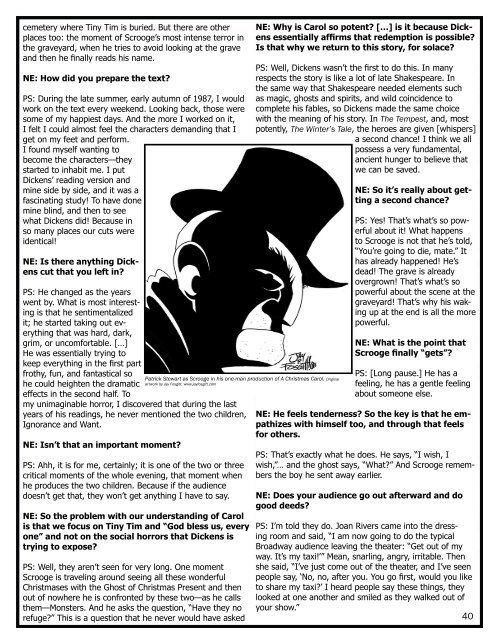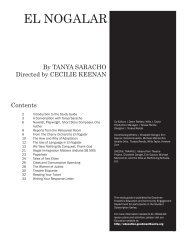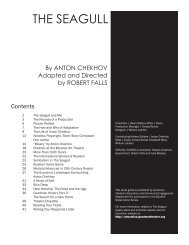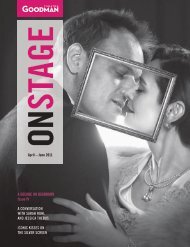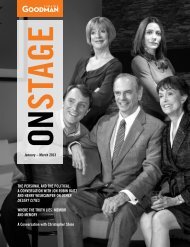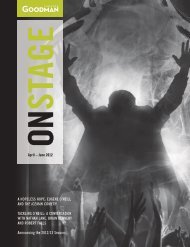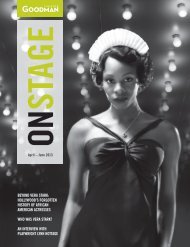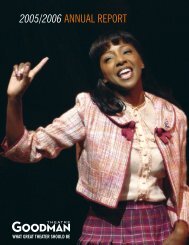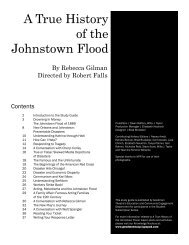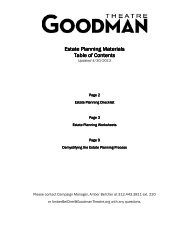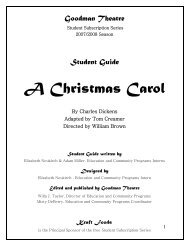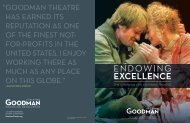A Christmas Carol Study Guide.indd - Goodman Theatre
A Christmas Carol Study Guide.indd - Goodman Theatre
A Christmas Carol Study Guide.indd - Goodman Theatre
Create successful ePaper yourself
Turn your PDF publications into a flip-book with our unique Google optimized e-Paper software.
cemetery where Tiny Tim is buried. But there are other<br />
places too: the moment of Scrooge’s most intense terror in<br />
the graveyard, when he tries to avoid looking at the grave<br />
and then he finally reads his name.<br />
NE: How did you prepare the text?<br />
PS: During the late summer, early autumn of 1987, I would<br />
work on the text every weekend. Looking back, those were<br />
some of my happiest days. And the more I worked on it,<br />
I felt I could almost feel the characters demanding that I<br />
get on my feet and perform.<br />
I found myself wanting to<br />
become the characters—they<br />
started to inhabit me. I put<br />
Dickens’ reading version and<br />
mine side by side, and it was a<br />
fascinating study! To have done<br />
mine blind, and then to see<br />
what Dickens did! Because in<br />
so many places our cuts were<br />
identical!<br />
NE: Is there anything Dickens<br />
cut that you left in?<br />
PS: He changed as the years<br />
went by. What is most interesting<br />
is that he sentimentalized<br />
it; he started taking out everything<br />
that was hard, dark,<br />
grim, or uncomfortable. […]<br />
He was essentially trying to<br />
keep everything in the first part<br />
frothy, fun, and fantastical so<br />
he could heighten the dramatic<br />
effects in the second half. To<br />
my unimaginable horror, I discovered that during the last<br />
years of his readings, he never mentioned the two children,<br />
Ignorance and Want.<br />
NE: Isn’t that an important moment?<br />
Patrick Stewart as Scrooge in his one-man production of A <strong>Christmas</strong> <strong>Carol</strong>. Original<br />
artwork by Jay Fosgitt. www.jayfosgitt.com<br />
PS: Ahh, it is for me, certainly; it is one of the two or three<br />
critical moments of the whole evening, that moment when<br />
he produces the two children. Because if the audience<br />
doesn’t get that, they won’t get anything I have to say.<br />
NE: So the problem with our understanding of <strong>Carol</strong><br />
is that we focus on Tiny Tim and “God bless us, every<br />
one” and not on the social horrors that Dickens is<br />
trying to expose?<br />
PS: Well, they aren’t seen for very long. One moment<br />
Scrooge is traveling around seeing all these wonderful<br />
<strong>Christmas</strong>es with the Ghost of <strong>Christmas</strong> Present and then<br />
out of nowhere he is confronted by these two—as he calls<br />
them—Monsters. And he asks the question, “Have they no<br />
refuge?” This is a question that he never would have asked<br />
NE: Why is <strong>Carol</strong> so potent? […] is it because Dickens<br />
essentially affirms that redemption is possible?<br />
Is that why we return to this story, for solace?<br />
PS: Well, Dickens wasn’t the first to do this. In many<br />
respects the story is like a lot of late Shakespeare. In<br />
the same way that Shakespeare needed elements such<br />
as magic, ghosts and spirits, and wild coincidence to<br />
complete his fables, so Dickens made the same choice<br />
with the meaning of his story. In The Tempest, and, most<br />
potently, The Winter’s Tale, the heroes are given [whispers]<br />
a second chance! I think we all<br />
possess a very fundamental,<br />
ancient hunger to believe that<br />
we can be saved.<br />
NE: So it’s really about getting<br />
a second chance?<br />
PS: Yes! That’s what’s so powerful<br />
about it! What happens<br />
to Scrooge is not that he’s told,<br />
“You’re going to die, mate.” It<br />
has already happened! He’s<br />
dead! The grave is already<br />
overgrown! That’s what’s so<br />
powerful about the scene at the<br />
graveyard! That’s why his waking<br />
up at the end is all the more<br />
powerful.<br />
NE: What is the point that<br />
Scrooge finally “gets”?<br />
PS: [Long pause.] He has a<br />
feeling, he has a gentle feeling<br />
about someone else.<br />
NE: He feels tenderness? So the key is that he empathizes<br />
with himself too, and through that feels<br />
for others.<br />
PS: That’s exactly what he does. He says, “I wish, I<br />
wish,”… and the ghost says, “What?” And Scrooge remembers<br />
the boy he sent away earlier.<br />
NE: Does your audience go out afterward and do<br />
good deeds?<br />
PS: I’m told they do. Joan Rivers came into the dressing<br />
room and said, “I am now going to do the typical<br />
Broadway audience leaving the theater: “Get out of my<br />
way. It’s my taxi!’” Mean, snarling, angry, irritable. Then<br />
she said, “I’ve just come out of the theater, and I’ve seen<br />
people say, ‘No, no, after you. You go first, would you like<br />
to share my taxi?’ I heard people say these things, they<br />
looked at one another and smiled as they walked out of<br />
your show.”<br />
40


